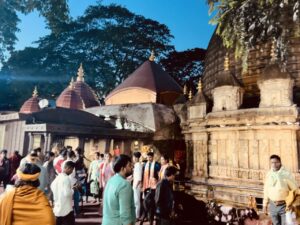In the first part, we started to look at the history of tantra from quite a long way back and found that the prehistory of tantra is linked to the fertility goddess or matriarchal culture. You can find out how in this article.
At the same time, tantra is not a tradition that merely celebrates the feminine principle, but holds equally important and sacred both the feminine and masculine energies, which always coexist. Let us now take a closer look at how classical tantra evolved.
The earliest tantric texts date from the 5th-7th century. It is generally agreed that this is the time when tantra, with its distinctive teachings, was born in India. Although a much earlier date is suggested, these claims are not substantiated.
At the time of Tantra’s birth, religions such as Shaivism and Buddhism were already in existence, with which Tantra is closely associated, and which have historically incorporated Tantra teachings. Historically, tantra teachings later moved from Shaivism, which originated in India, to Buddhism. In particular, tantric principles abound in Tibetan Buddhism.
It is important to emphasise that, whatever religion tantra comes into contact with in history, tantra is never a religion, but a spiritual, mystical, esoteric doctrine that has always been very tolerant of practitioners and has always aimed at the attainment/enlightenment of divinity.
Tantra evolved out of a form of Shaivism called Atimarga, or “The Highest Way”. This doctrine considered itself superior to conventional society as well as religion. Atimarga was only available to the highest caste in India, the Brahmins, and only to men.
It was a rather radical doctrine of liberation from the ego and the fear of death by developing a detachment from the body, with the aim of attaining divinity or enlightenment.
The followers of Atimarga meditated, among other things, in the places of cremation, abandoned their clothes and walked the streets as beggars covered in ashes, the beggar’s cloak being the human trunk. All this was considered necessary to reduce the practitioner’s social programming and to reduce human evils.
Atimarga influenced classical tantra in at least three ways. First, the practice of yoga and meditation for spiritual awakening. Second, transcending levels of reality to become one with the divine, and third, transcending karma through practices that defy social or moral norms.
Tantra initially develops in two main directions.
One of them is the Shiva or man-energy-centred tantric teaching called Shiva Siddhanta, which was a dual teaching by nature. That is, divinity could only be attained after death and even when equality with God was attained, the human soul and God always remained separate.
This school of thought does not consider the sanctification of Shakti, or feminine energy, necessary and believes that spiritual liberation can only come through ritual initiation and practice. It also avoided practices that would be contrary to the moral norms of society.
The second school of tantra is non-dual, which considers enlightenment possible within one lifetime and while still in the earthly body – here and now. It includes teachings where male energy, or Shiva, and female energy, or Shakti, are equally important for achieving spiritual liberation.
This doctrine is called Kaula Tantra, although it is claimed that the followers of this doctrine never called themselves that. Kaula Tantra has not been afraid to challenge social morality with its practices, but it has always had a spiritual purpose, not simply a desire to antagonise.
Kaula tantra has its origins in the matriarchal culture of the goddesses, and from there come practices for working with very different forms of Shakti, or female energy. In addition, Kaula tantra has a connection with the shamanism-like tradition practised in India. As is customary in shamanism, the Kaula tantra practitioners also interacted with various nature spirits and elements, worshipped both gentle and fearsome goddesses, and used blood in rituals.
Kaula tantra also aimed at transcending the ego and enlightenment through yoga and meditation practices, as well as identification with various divine energies and visualisation.
Classical tantra is rather based on Kaula Tantra or non-dual tantra. So what makes tantra tantra, what are the most basic teachings? You can read all about it in the next article.
*This article is based on texts from the book “Tantra illuminated” by C.D. Wallis, 2012.






